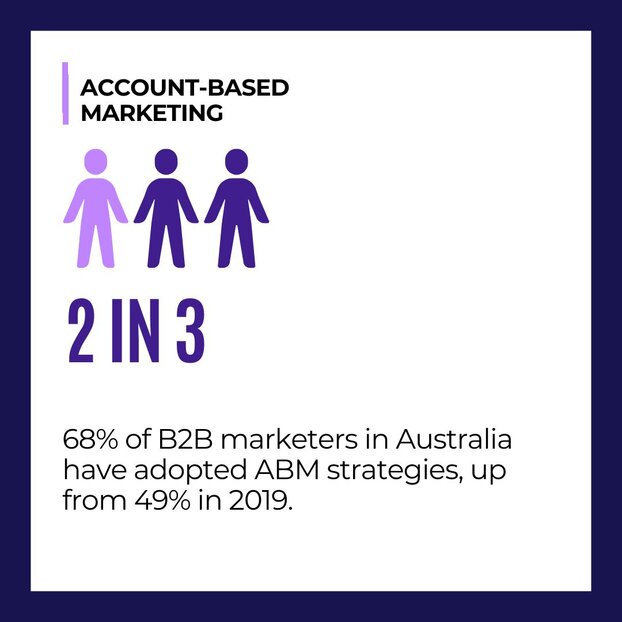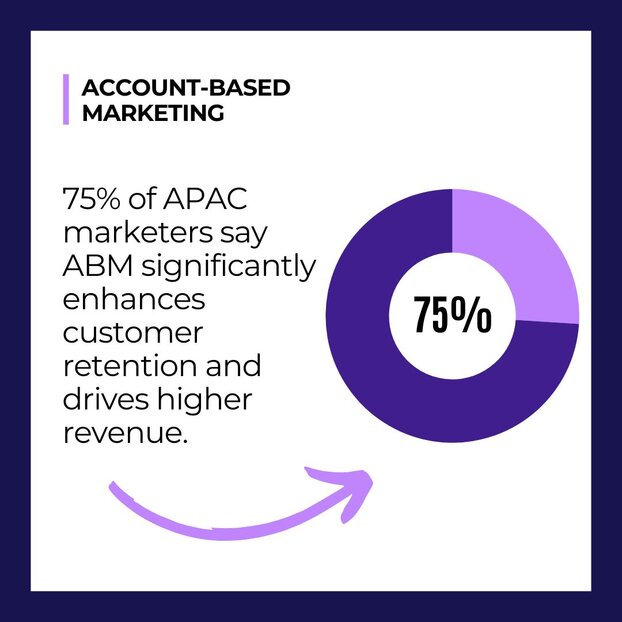ABM Sales Strategy
For the APAC Region
Account-Based Marketing (ABM) is revolutionising the sales landscape, particularly in the APAC region. ABM is a strategic approach that aligns sales and marketing efforts to target high-value accounts, rather than casting a wide net over potential customers. This method is gaining traction in Australia, where businesses are recognising the need for personalised, targeted marketing efforts to stand out in a crowded market.
Recent statistics highlight the growing importance of ABM in the APAC region. According to a report by Demand Gen Report, 75% of marketers in APAC reported that ABM significantly enhances customer retention and drives higher revenue.
Additionally, Forrester Research indicates that companies practising ABM generate 208% more revenue for their marketing efforts compared to those that don't. In Australia specifically, 68% of B2B marketers have adopted ABM strategies, up from 49% in 2019, showcasing a rapid adoption rate driven by its proven effectiveness.

The core principle of ABM is the focus on the Total Addressable Market (TAM). This involves identifying the universe of potential accounts that could benefit from your product or service, segmenting them based on strategic value, and then tailoring personalised campaigns to engage these high-value targets. Unlike traditional marketing, which often prioritises volume over value, ABM emphasises quality engagements with prospects who are most likely to convert and bring substantial revenue.
ABM In-market Buyers vs Out-of-market Buyers
A crucial aspect of this approach is distinguishing between in-market buyers and out-of-market buyers. In-market buyers are those actively seeking solutions similar to what you offer. They have demonstrated intent and are more likely to engage with your marketing efforts and convert into customers. Identifying these buyers involves leveraging intent data, which tracks online behaviour indicating a readiness to purchase, such as visiting relevant websites, downloading industry reports, or engaging with related content.
Conversely, out-of-market buyers are not currently seeking your product or service. These accounts might still hold long-term potential, but they require a different strategy. Engaging with out-of-market buyers focuses on building brand awareness and nurturing relationships until they enter the buying cycle. This is where ABM's emphasis on personalised and targeted engagement becomes critical.
For example, in-market buyers can immediately engage with high-intent content such as detailed product demos, case studies showcasing specific benefits, and direct consultations. These efforts aim to swiftly move them through the sales funnel, given their readiness to purchase.
Out-of-market buyers, on the other hand, benefit from broader, value-driven content aimed at educating and building trust. Thought leadership articles, industry webinars, and strategic social media interactions help keep your brand top-of-mind until these prospects transition into an active buying phase.
The segmentation of your TAM into in-market and out-of-market buyers ensures that your marketing efforts are not only efficient but also highly effective. By aligning your resources and messaging to the specific needs and readiness levels of different accounts, you can maximise engagement and conversion rates.
In the context of the APAC region, this approach is particularly valuable due to the diverse market dynamics. For instance, a technology firm targeting large financial institutions in Australia might focus its immediate, high-intent ABM efforts on banks actively seeking digital transformation solutions. Simultaneously, the firm can nurture relationships with other financial entities that may not be currently in the market but show potential for future engagement.
By understanding and leveraging the distinction between in-market and out-of-market buyers, businesses can tailor their ABM strategies to capture immediate opportunities and build a pipeline for future growth. This dual approach ensures sustained engagement and maximises the return on marketing investments in the dynamic APAC market.

Account-Based Marketing Types: 1:1, 1:Few, and 1:Many
ABM is not a monolithic approach but rather a spectrum that includes different levels of personalisation: 1:1, 1:Few, and 1:Many. Each type serves distinct purposes and suits different stages of the sales cycle.
1:1 ABM is the most personalised approach, often referred to as "Strategic ABM." This method involves creating bespoke marketing plans for individual accounts. It's akin to a white-glove service where every touchpoint is tailored to the specific needs and preferences of a single account. This approach is ideal for targeting high-value clients who can significantly impact your revenue. For example, an Australian tech firm might create a custom event for a large banking institution, addressing their unique pain points and aligning solutions with their strategic goals. This deep personalisation fosters strong relationships and can lead to long-term partnerships.
1:Few ABM, or "ABM Lite," targets small clusters of similar accounts. These accounts share common characteristics, such as industry, company size, or specific needs. This approach allows for some level of personalisation without the intensive resource investment of 1:1 ABM. It’s effective for mid-tier accounts that, while not as individually lucrative as those targeted by 1:1 ABM, collectively represent a significant revenue opportunity. For instance, an Australian SaaS company might develop a campaign for a group of healthcare providers, focusing on shared regulatory challenges and operational needs.
1:Many ABM, or "Programmatic ABM," casts a wider net by targeting larger groups of accounts with common attributes. This approach leverages technology to scale personalised messages to a broader audience. It’s suitable for lower-value accounts that, although individually less significant, collectively contribute to substantial revenue. Programmatic ABM employs data-driven insights to create semi-personalized content at scale. For example, an Australian marketing agency might run a digital campaign targeting small and medium-sized enterprises (SMEs) across various industries, focusing on common challenges like digital transformation and market competition.
ABM is a game-changer for B2B marketing. By focusing on high-value accounts and delivering personalized campaigns, ABM allows companies to be more strategic and targeted in their marketing efforts, resulting in higher conversion rates, increased engagement, and improved alignment between sales and marketing teams.
Brian Sharp, Vice President of Marketing, LeanData
Account-Based Marketing Strategy
Developing a robust ABM strategy requires meticulous planning and alignment between marketing and sales teams. Here are the key components that need to be addressed:
Defining Objectives and KPIs
The first step in an ABM strategy is to clearly define your objectives and key performance indicators (KPIs). Objectives could include increasing revenue from key accounts, improving customer retention, or penetrating new market segments. KPIs should be aligned with these objectives and could range from engagement metrics (e.g., email open rates, website visits) to financial metrics (e.g., deal size, revenue growth).
Identifying Target Accounts
Identifying and selecting the right accounts is critical. Use data-driven insights to pinpoint accounts that align with your business goals and have the highest potential for revenue generation. Consider factors such as company size, industry, geographic location, and buying behaviour. In the APAC region, leveraging local market intelligence and cultural nuances can significantly enhance account selection accuracy.
Developing Personalised Content
Content is the backbone of ABM. For each target account or cluster, develop highly personalised content that addresses their specific needs, pain points, and goals. This can include custom landing pages, tailored email campaigns, personalised webinars, and bespoke case studies. Personalisation increases engagement and demonstrates your commitment to understanding and solving the account’s unique challenges.
Aligning Sales and Marketing Efforts
Successful ABM requires seamless collaboration between sales and marketing teams. Both teams should work together to develop account plans, share insights, and align on messaging. Regular meetings and integrated workflows ensure that efforts are coordinated and that accounts receive a consistent experience across touchpoints.
Implementing Multi-Channel Campaigns
An effective ABM strategy leverages multiple channels to engage target accounts. This includes digital channels like email, social media, and paid ads, as well as direct channels like events, webinars, and personalised direct mail. In the APAC region, consider incorporating local social media platforms and regional events to enhance engagement.
Utilising Technology and Tools
ABM platforms and tools play a crucial role in executing and scaling ABM campaigns. To manage and measure campaigns, utilise technologies like CRM systems, marketing automation platforms, and ABM-specific tools. These tools enable data-driven decision-making and provide insights into account engagement and campaign performance.
Measuring and Optimising
Regular measurement and optimisation are essential to ensure the success of ABM campaigns. Track KPIs and analyze the performance of each campaign. Use insights to refine your strategy, improve targeting, and enhance personalisation. Continuous optimisation ensures that your ABM efforts remain effective and deliver maximum ROI.
ABM Campaigns: Duration, Metrics, and Assets
ABM campaigns are not a one-and-done effort; they require sustained engagement and continual refinement. Here’s a detailed look at how to manage ABM campaigns effectively.
Campaign Duration: The duration of an ABM campaign can vary depending on the type of ABM and the sales cycle of the target accounts. For 1:1 ABM, campaigns can run for several months to a year, reflecting the longer sales cycles and the need for deep engagement. 1:Few and 1:Many ABM campaigns might have shorter durations, ranging from a few weeks to several months, depending on the complexity and size of the target accounts.
Key Metrics to Measure: Measuring the success of ABM campaigns requires a mix of quantitative and qualitative metrics. Key metrics include:
- Engagement Metrics: Track metrics such as email open rates, click-through rates, website visits, and social media interactions to gauge engagement levels.
- Pipeline Metrics: Monitor metrics like the number of new opportunities, pipeline velocity, and deal size to assess the impact on the sales pipeline.
- Revenue Metrics: Measure the increase in revenue from target accounts, average deal size, and customer lifetime value.
- Relationship Metrics: Use metrics like Net Promoter Score (NPS) and customer satisfaction scores to evaluate the strength of relationships with target accounts.

Essential ABM Assets: Creating and deploying the right assets is critical for ABM's success. Essential assets include:
- Personalised Landing Pages: Develop landing pages tailored to each target account or cluster, highlighting relevant content and offers.
- Tailored Email Campaigns: Craft personalised email sequences that address the specific needs and pain points of each account.
- Custom Content: Produce content such as case studies, whitepapers, and blog posts that resonate with target accounts.
- Webinars and Events: Host webinars and events tailored to the interests and challenges of target accounts, providing valuable insights and fostering engagement.
- Direct Mail: Utilise personalised direct mail to create a tangible connection and stand out digitally.
ABM Marketing: Aligning Sales and Marketing
The success of ABM hinges on the alignment between sales and marketing teams. In traditional marketing approaches, these teams often operate in silos, leading to misaligned goals and disjointed customer experiences. ABM necessitates a collaborative approach where both teams work in tandem to achieve shared objectives.
Defining Roles and Responsibilities
Clearly defining the roles and responsibilities of sales and marketing teams is crucial. Marketing is responsible for developing the overarching strategy, creating personalised content, and managing multi-channel campaigns. Sales, on the other hand, focuses on account identification, relationship building, and closing deals. Both teams should share insights and work together to refine the strategy based on real-time feedback.
Developing Integrated Account Plans
Sales and marketing should co-develop integrated account plans for each target account. These plans should outline the objectives, strategies, and tactics for engaging and converting the account. Regular collaboration ensures that both teams are aligned on messaging, timing, and engagement tactics.
Sharing Insights and Data
Effective ABM requires a data-driven approach. Sales and marketing teams should share insights and data to inform strategy and optimise campaigns. This includes sharing account intelligence, engagement metrics, and feedback from customer interactions. Leveraging shared data ensures that efforts are coordinated and that campaigns are continuously refined.
Ensuring Consistent Messaging
Consistency in messaging is key to delivering a seamless customer experience. Sales and marketing teams should align on the messaging and ensure that communications are coherent across all touchpoints. This reinforces the value proposition and builds trust with target accounts.
Leveraging Technology for Collaboration
Utilise technology to facilitate collaboration between sales and marketing. CRM systems, marketing automation platforms, and ABM-specific tools provide a centralised platform for managing campaigns, tracking engagement, and sharing insights. These tools enhance transparency, streamline workflows, and improve efficiency.
Fostering a Culture of Collaboration
Beyond processes and tools, fostering a culture of collaboration is essential for ABM marketing success. Encourage open communication, regular feedback, and mutual respect between sales and marketing teams. Recognise and reward collaborative efforts to reinforce the importance of alignment.
ABM is a powerful strategy that requires meticulous planning, seamless collaboration, and sustained engagement. By understanding the different types of ABM, developing a robust strategy, managing campaigns effectively, and aligning sales and marketing efforts, businesses in the APAC region can create significant growth opportunities and build lasting relationships with high-value accounts.
$66million via ABM
and Social Selling for Lenovo
Tech Revolution stands as a trailblazing digital content platform created for Lenovo with Intel as a partner.
It was curated for the mobile era, dedicated to furnishing IT decision-makers throughout the Asia-Pacific region with the latest tech insights.
Our milestones include:
Demonstrating a tangible return on investment within a span of just 12 months.
Earning the distinction of being recognised by LinkedIn's global content evangelist as one of the top 1% of content marketing sites globally.
A nomination for the esteemed "Best Content Marketing & Collaboration" award, presented by mUmBRELLA Asia.
Attracting and engaging prominent industry influencers to contribute their perspectives to the Tech Revolution.